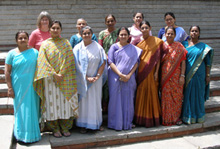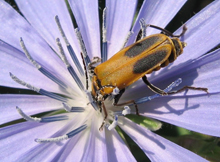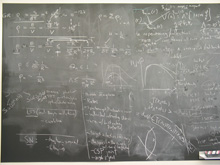 | Friday, April 14, 2006 |
|
Friday, April 14
Monday, April 17 |
|
|
Secon Level 3 |
|
Friday, April 14 -Cream of Wild Mushroom -Blackened Fish Filet Sandwich -Southern Fried Chicken -Fish Mediterranean -Eggplant Parmesan Panini -Pizza Supreme -Assorted Sub Sandwich |
|
Wednesday, April 19
Thursday, April 20
Chez Leon Menu |
| Fermilab Today is online at: http://www.fnal.gov/today/ Send comments and suggestions to today@fnal.gov Hurricane Relief Page Fermilab Today archive Fermilab Today PDF Version Fermilab Result of the Week archive Fermilab Safety Tip of the Week archive Linear Collider News archive Fermilab Today classifieds Subscribe/Unsubscribe to |
|
|
The Post Chronicle, April 13, 2006: Fermilab Clocks Matter-Antimatter 'Dance' BATAVIA, Ill. - April 11, 2006 (UPI) -- Scientists at the Fermi National Accelerator Laboratory in Batavia, Ill., say they've measured the rapid transitions between matter and anti-matter. The researchers at the U.S. Department of Energy facility said it's been known for 50 years that very special species of subatomic particles can make spontaneous transitions between matter and antimatter. In the new research, physicists measured the rate of those matter-antimatter transitions at 3 trillion times per second. "Exploration of the anti-world's mysteries is a crucial step towards our understanding of the early universe, and how we came to be," said Raymond Orbach, director of the DOE's Office of Science.
Scientists hope that by assembling a large number of precise measurements involving the exotic behavior of the particles, they can begin to understand why they exist, how they interact with one another and what role they played in the development of the early universe.
|
| What's on your wall? Snapshot a la chalkboard | ||
|
||
|
Empty chalkboards are all alike; every overflowing chalkboard is overflowing in its own way. Like much of what happens here at the lab, the chalkboards and whiteboards often reflect the combination of exciting science and routine details that make up a scientist's days here. The chalkboard of astrophysicist Josh Frieman includes everything from a rough budget sketch for a project still in R&D to diagrams that, though they look suspiciously similar, in fact describe two very different, major cosmological phenomena.
The diagram on the left is a plot of supernovae luminosity as a function of time. The plot shows that supernovae that fade more quickly also tend to be intrinsically less bright (bottom curve). Knowing this, astrophysicists use supernovae as "standard candles" to measure cosmic distances. "We want to use those to figure out how fast the universe has been expanding. And then use that to tell us about dark energy, the stuff causing the universe to speed up," says Frieman.
The other diagram shows the number of galaxy clusters as a function of their distance from us. Nearby, there will be a few clusters; at some middle distance, there will be a lot of clusters; and then really far away, again there are fewer clusters. "As you go out in distance, you're also going back in time," says Frieman. "If I look really far away, I expect to see few clusters because they haven't had time to form. How long clusters take to form depends in part on the rate at which the universe grows. That rate in turn depends on the dark energy."
|
| Designing the Perfect Cryomodule for the ILC | ||
| ||
|
Using state-of-the-art technology, cryomodules are vessels that contain superconducting cavities in a linear accelerator. Inside the module, liquid helium cools the cavities to -271° C, only slightly warmer than the coldest possible temperature. The superconducting cavities operate at these super-cool temperatures, pumping more and more energy into the particles that are moving at nearly the speed of light inside the accelerator.
Read More
|
|
Fermilab Association of Rocketry The Fermilab Association of Rocketry (FAR) is having it's first monthly club launch of the new season on April 15, 2006 from 10 a.m. until 3 p.m. We'd also like to thank everyone that came to our booth and signed up during the fair on the April 12. Hope to see you at th e-launch! More details can be found on our website.
NALWO Cooking Demonstration
Power Outage
Professional Development New classified ads have been posted on Fermilab Today. |



